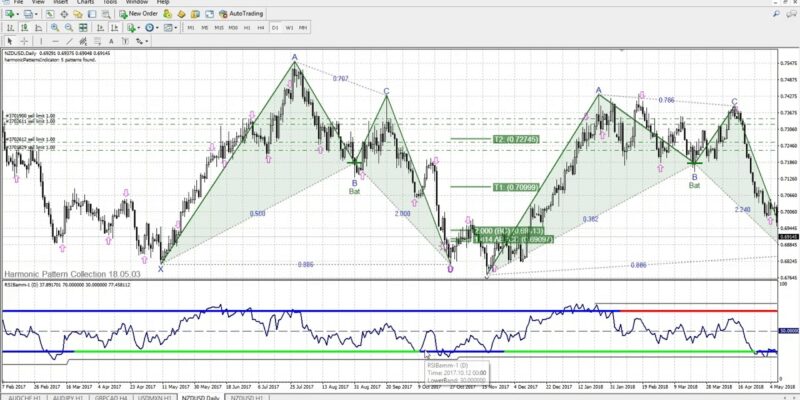
The Relative Strength Index (RSI) is a popular momentum indicator used by traders to identify overbought and oversold conditions in the market. The RSI BAMM indicator is a modified version of RSI that helps improve trade signals and timing. In this post, we’ll take a deep dive into how the RSI BAMM works and how traders can apply it to their charts.
What is the RSI BAMM Indicator?
The RSI BAMM (Buy and Maintain Monitor) indicator is a variation of the popular Relative Strength Index (RSI) indicators. It is specifically designed for long-term investors or traders who adopt a “buy and maintain” approach to trading. The RSI BAMM indicator combines elements from the RSI indicator with a long-term trend component to provide valuable insights into the overall market sentiment just like what Elliott Wave theory does.
The RSI BAMM indicator consists of two main components:
1. RSI Component: Similar to the traditional RSI indicator, the RSI component of the RSI BAMM indicator measures the momentum of an asset. It calculates the ratio of upward price movements to downward price movements over a specified period. This component helps traders identify overbought and oversold levels, which can be used as signals to enter or exit positions.
2. Long-Term Trend Component: The long-term trend component of the RSI BAMM indicator determines the overall direction of the market. It takes into account factors such as moving averages, trend lines, or other trend indicators to give traders a broader perspective on the market. By analyzing the long-term trend, traders can filter out short-term market fluctuations and focus on long-term trends.
By combining the RSI and long-term trend components, the RSI BAMM indicator provides traders with a powerful tool to identify potential entry and exit points. It can also help confirm trend reversals and enable traders to set effective stop losses and take profit levels. However, it is important to note that like any technical indicator, the RSI BAMM indicator should be used in conjunction with other analysis techniques and risk management strategies for optimal results.
How to Trade with the RSI BAMM?
Trading with the RSI BAMM (Buy And Monitor) indicator involves a combination of interpreting the RSI component and the long-term trend component. Here are some steps on how to trade with the RSI BAMM indicator:
- Identify Overbought and Oversold Levels
Similar to the traditional RSI indicator, the RSI BAMM indicator can help identify overbought and oversold levels. When the RSI value is above a certain threshold, typically 70, it indicates that the asset may be overbought and a reversal or pullback could occur. Conversely, when the RSI value is below a certain threshold, typically 30, it suggests that the asset may be oversold and a bounce-back or upward movement could happen. Traders can use these levels as signals to potentially enter or exit positions.
- Confirm Trend Reversals
The RSI BAMM indicator can be useful for confirming trend reversals. When the RSI BAMM indicator shows a divergence or convergence with the price, it indicates a potential trend reversal. For example, if the price is making higher highs while the RSI BAMM indicator is making lower highs, it could indicate a bearish divergence and suggest that a trend reversal is likely. Traders can use these signals as additional confirmation when considering their trading decisions.
- Filter for Long-Term Trend Trading
The RSI BAMM indicator is particularly beneficial for traders who follow a buy-and-maintain strategy. By incorporating the long-term trend component, traders can filter out short-term market fluctuations and focus on the long-term trend. This helps traders identify potential entry points during a market uptrend or exit points during a market downtrend. It is essential to analyze the long-term trend before relying solely on the RSI BAMM indicator signals.
- Set Stop Loss and Take Profit levels
Traders can use the RSI BAMM indicator to set effective stop loss and take profit levels. By analyzing the indicator’s signals in conjunction with other technical analysis tools, such as support and resistance levels or trend lines, traders can manage their risk and maximize their potential profits. For example, if the RSI BAMM indicator suggests an overbought condition, traders may consider placing a stop loss below a significant support level to protect against a potential downward reversal.
Remember that the RSI BAMM indicator is just one tool among many in your trading arsenal. It is crucial to combine its signals with other technical indicators, fundamental analysis, and risk management strategies to make well-informed trading decisions. Additionally, it is advisable to backtest and validate the indicator’s performance on historical data before applying it to live trading.
What are RSI BAMM indicator components?
The RSI BAMM (Buy and Monitor) indicator consists of two main components: the RSI component and the long-term trend component.
1. RSI Component: The RSI component of the RSI BAMM indicator measures the momentum of an asset. It calculates the ratio of upward price movements to downward price movements over a specified period, typically 14 periods. The RSI ranges from 0 to 100 and is plotted on a graph. A reading above 70 is generally considered overbought, indicating a potential reversal or pullback, while a reading below 30 is considered oversold, suggesting a possible bounce-back or upward movement. Traders can use these overbought and oversold levels as signals to potentially enter or exit positions.
2. Long-Term Trend Component: The long-term trend component of the RSI BAMM indicator helps determine the overall direction of the market and complements the RSI component. It takes into account factors such as moving averages, trend lines, or other trend indicators to provide a broader perspective on the market. By analyzing the long-term trend, traders can filter out short-term market fluctuations and focus on identifying long-term trends. This component can be used to confirm trend reversals identified by the RSI component and provide additional context to trading decisions.
By combining these two components, the RSI BAMM indicator provides traders with a comprehensive tool for understanding the momentum of an asset and the broader market trend. It can help identify potential entry and exit points, confirm trend reversals, and aid in setting effective stop loss and take profit levels. However, it is important to note that the RSI BAMM indicator should be used in conjunction with other analysis techniques and risk management strategies for optimal trading decisions.
Benefits and drawbacks of RSI BAMM indicator
Here are some of the key benefits and drawbacks of using the RSI BAMM indicator for trading analysis:
Pros:
- Faster signal generation – Reacts quicker to changing market momentum and trends compared to standard RSI.
- Smoother indicator lines – Bidirectional smoothing filters out noise for a cleaner indicator.
- Improved peak/valley detection – Tops and bottoms are more distinct and defined vs. regular RSI.
- Clearer divergence signals – Divergences stand out better, improving reversal detection.
- Customizable settings – Values can be adjusted to suit different trading styles and assets.
- Works across timeframes – Effective for both short-term and long-term trading.
- Widely available – Offered on most trading platforms and charting software.
Cons:
- Repainting – Like any momentum indicator, repainting can occur with line adjustments.
- Requires tuning – Default settings may need adjustment to maximize performance.
- Lagging indicator – There is still some lag like any indicator derived from past prices.
- Too sensitive – A very fast oscillator can be prone to false signals during ranging or choppy markets.
- No trading system – BAMM must be combined with other analyses for a complete system.
In conclusion
The RSI BAMM indicator takes the widely used RSI indicator and makes enhancements to provide more reliable and timely trading signals. Advanced filtering and bidirectional smoothing allow spotting trend changes faster. All traders using the RSI should give the RSI BAMM a try.











